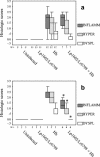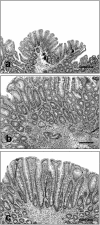Probiotic Lactobacillus spp. diminish Helicobacter hepaticus-induced inflammatory bowel disease in interleukin-10-deficient mice
- PMID: 15664933
- PMCID: PMC547020
- DOI: 10.1128/IAI.73.2.912-920.2005
Probiotic Lactobacillus spp. diminish Helicobacter hepaticus-induced inflammatory bowel disease in interleukin-10-deficient mice
Abstract
Clinical and experimental evidence has demonstrated the potential role of probiotics in the prevention or treatment of inflammatory bowel disease. Probiotic clones with direct immunomodulatory activity may have anti-inflammatory effects in the intestine. We investigated the roles of tumor necrosis factor alpha (TNF-alpha)-inhibitory Lactobacillus clones with a pathogen-induced murine colitis model. Murine-derived probiotic lactobacilli were selected in vitro for their ability to inhibit TNF-alpha secretion by Helicobacter hepaticus-stimulated macrophages. Interleukin-10 (IL-10)-deficient mice were treated with probiotic Lactobacillus reuteri in combination with Lactobacillus paracasei and then challenged with H. hepaticus. Ten weeks postinoculation, the severity of typhlocolitis was assessed by histologic examination of the cecocolic region. Intestinal proinflammatory cytokine responses were evaluated by real-time quantitative reverse transcriptase PCR and immunoassays, and the quantities of intestinal H. hepaticus were evaluated by real-time PCR. Intestinal colonization by TNF-alpha-inhibitory lactobacilli reduced intestinal inflammation in H. hepaticus-challenged IL-10-deficient mice despite similar quantities of H. hepaticus in cocolonized animals. Proinflammatory colonic cytokine (TNF-alpha and IL-12) levels were lowered in Lactobacillus-treated animals. In this H. hepaticus-challenged IL-10-deficient murine colitis model, lactobacilli demonstrated probiotic effects by direct modulation of mucosal inflammatory responses.
Figures








References
-
- Borruel, N., F. Casellas, M. Antolin, M. Llopis, M. Carol, E. Espiin, J. Naval, F. Guarner, and J. R. Malagelada. 2003. Effects of nonpathogenic bacteria on cytokine secretion by human intestinal mucosa. Am. J. Gastroenterol. 98:865-870. - PubMed
-
- Christensen, H. R., H. Frokiaer, and J. J. Pestka. 2002. Lactobacilli differentially modulate expression of cytokines and maturation surface markers in murine dendritic cells. J. Immunol. 168:171-178. - PubMed
-
- Cruchet, S., M. C. Obregon, G. Salazar, E. Diaz, and M. Gotteland. 2003. Effect of the ingestion of a dietary product containing Lactobacillus johnsonii La1 on Helicobacter pylori colonization in children. Nutrition 19:716-721. - PubMed
-
- Da Silva, J. A. 1999. Sex hormones and glucocorticoids: interactions with the immune system. Ann. N. Y. Acad. Sci. 876:102-117. - PubMed
Publication types
MeSH terms
Substances
Grants and funding
LinkOut - more resources
Full Text Sources
Other Literature Sources
Molecular Biology Databases
Miscellaneous

